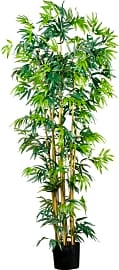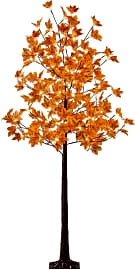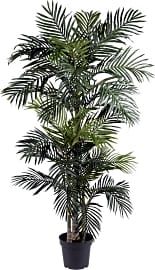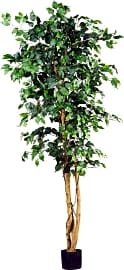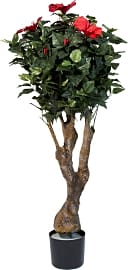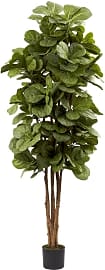The 10 Best Artificial Trees

This wiki has been updated 37 times since it was first published in July of 2015. Do you have a black thumb? No problem. You can still enjoy the beauty of greenery without having to worry about watering, pruning, or pesky bugs. Just check out our selection of artificial trees, which includes ficus, palms, fiddle leaf figs, and more. They offer a simple and affordable way to bring a low-maintenance decorative touch to any room in the house. When users buy our independently chosen editorial choices, we may earn commissions to help fund the Wiki.
Editor's Notes
March 16, 2019:
The Nearly Natural Banana Tree and Nearly Natural Hibiscus were removed due to complaints about these trees not having a realistic appearance despite the listings’ claims. The Lightshare Maple, on the other hand, may not look realistic, but the difference is that it isn’t supposed to, which is why it remains on the list. New additions include the Pure Garden Hibiscus and the Pure Garden Hedyotis. The former product was chosen to provide blossom-lovers a suitable option, while the latter is intended to please topiary enthusiasts.
Born With A Black Thumb
Of course, if you simply get tired of a real tree, getting rid of it will be just as difficult.
It isn’t always easy to admit to the things we aren’t good at, but I can say with confidence that I was not born to be a gardener. In fact, I would go so far as to say that my thumbs are so black that, rather like black holes, no light seems to escape them. Is it genetics? Probably not. Is it a curse? Maybe.
Whatever the cause, any plant I’ve ever owned and tended to has eventually died, usually well before it should have. And it’s not like I was fighting above my weight class here either, choosing difficult varieties and species that would challenge even the greenest of thumbs. No, in my life I have killed bamboo, bonsai, cacti, and just about any other species of plant that is usually recommended to people with a history of sapping the life from garden organisms.
For someone like me, artificial plants of any variety boon. They allow me to use lush green foliage to decorate around my apartment without having to worry about my particular relationship with plants eventually causing them to whither and crumble. In larger spaces, artificial trees are particularly useful, especially when landscape design matters to you. Of course, that’s not to say that artificial trees are only meant for outdoor installations. Many spaces can benefit from small indoor trees that can bring a genuine sense of environment to home or office.
Artificial trees are remarkably easy to care for, since no aspect of them is alive. That means people like me with black thumbs don’t need to take any extra precautions to prevent their untimely death. But you don’t have to have a black thumb to justify the use of an artificial tree over the real thing. Anyone with a particularly busy life can appreciate the low maintenance that these installations offer. Even if you know you’ll be home throughout most of the year, but you also know that you occasionally take vacations of a week or more, you’ll be relieved not to have to call in a favor from a friend to come water your tree every couple of days.
Another advantage of the artificial tree arises if and when you decide to move or simply get tired of the tree you chose. When you have a real tree, and a move is around the corner, it’s a rather hairy prospect to try to take it with you. A real tree will have sprouted roots and maybe even become home to some local wildlife. That makes removing it and taking it to a new location both hazardous to its current environment and dangerous for its future health. You don’t know for sure whether it will take root in its new location, and you could end up with a dead tree on your hands after all that work and expense. Of course, if you simply get tired of a real tree, getting rid of it will be just as difficult. With an artificial tree, however, you could do something as simple as dropping it off at your local Goodwill.
Choosing The Perfect Tree For Your Space
More than anything else, picking an artificial tree for your space is going to have a lot to do with your sense of style. You may find that a certain look complements your space better than another, or that the specific color of a leaf or flower on a tree appeals to you. There are also certain superstitious associations between tree species and things like luck in finance or love. Of course, that kind of superstition is usually contained to the world of living trees, but that’s no reason not to have a little fun with it.
The only major downside to silk is that it’s a bit more expensive, and that it tends to be a little more fragile.
If a number of trees catch your eye, you can start to look at some different aspects of their construction to ensure that you make a purchase you’ll be satisfied with for years to come. One important thing to look for is the material out of which a given trees leaves are constructed. The quality of this material will bear tremendously on how realistic the tree appears in person. Silk is probably the most realistic material used, as its weight allows the leaves to respond to breezes and other environmental factors the way real leaves would. The only major downside to silk is that it’s a bit more expensive, and that it tends to be a little more fragile. If you’re putting this tree in the corner of an office, it’ll probably be safe for the long-haul, but if it’s in a home with a handful of rambunctious children, you can expect a few of those leaves to be torn within the first year.
Beyond those basic considerations, things like height may be important to you, especially if you plan on placing the tree in a space of prominence. You also might want to consider whether the pot the tree comes in truly complements the tree itself or the space for which it’s intended. The good news here is that you can always buy a new piece of terra-cotta or so some similar pot and move your tree into it without worrying about damaging its roots (because it doesn’t have any).
Sprucing Up The Home And Office
If you’re buying an artificial tree to help spruce up the space in your office, in your house, or just outside the house, there are some additional ways you can take those environments to the next level.
In outdoor settings, for example, your artificial tree likely won’t attract too much wildlife. If you like the thought of having birds and other critters join you outside, you might want to get your hands on a nice bird bath and some high-quality feeders.
In the home or office, your artificial tree can be the first piece in a slow, but steady transformation of the space into a wondrous artificial wilderness. Consider adding a small fountain of running water, and a handful of smaller plants — either real or artificial — and you’ll feel a significant boost to the feng shui.


